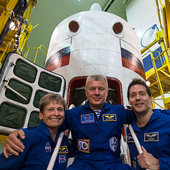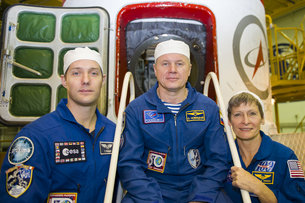Proxima mission begins
17 November 2016 ESA astronaut Thomas Pesquet, NASA astronaut Peggy Whitson and Roscosmos commander Oleg Novitsky blasted into space this evening from the Baikonur cosmodrome in Kazakhstan at 20:20 GMT. Their Soyuz MS-03 spacecraft is now safely heading towards the International Space Station for docking on Saturday.
After the spectacular launch that propelled the astronauts 1640 km in less than 10 minutes, the trio will now spend two days catching up with the International Space Station that orbits Earth at 28 800 km/h.
After the spectacular launch that propelled the astronauts 1640 km in less than 10 minutes, the trio will now spend two days catching up with the International Space Station that orbits Earth at 28 800 km/h.
The Soyuz spacecraft is a car-sized vehicle that has been ferrying people to space for almost 50 years. Thomas, Peggy and Oleg will circle Earth 34 times before arriving at the Space Station at 22:00 GMT on Saturday.
The journey is relatively smooth and quiet after the rigours of launch. With no Internet or satellite phones, the crew relies on radio to communicate at set intervals with ground control.
Thomas is the first French astronaut to visit the Space Station since ESA astronaut Léopold Eyrharts helped to install Europe’s Columbus module in 2008. Peggy and Oleg have both flown before on a Soyuz – this is Peggy’s third expedition on the Station and her second time in command.
Proxima
Once Thomas enters the orbital complex, his Proxima mission begins with a short link-up with friends and family.
Nothing can prepare astronauts fully for weightlessness, but trainers on Earth do their best with underwater sessions, 20 second zero-g sessions on aircraft flights and virtual-reality sessions.
The first two weeks for Thomas will be spent getting used to living and working in microgravity. During this time, his body will adapt to living without the effects of gravity. His spine will grow longer, fluids in his body will shift towards his head and his bones will weaken.
In addition, Thomas needs to readjust his concept of space. Without weight, there is no traditional sense of up or down, left or right – it all depends on how you float. To make matters worse, any equipment, tools or food that is not fixed will float away.
Thomas has a full schedule of science and experiments planned for his six-month mission. In his first week on the Station he will start work on the Aquamembrane experiment that promises to simplify testing for water contamination, on Earth and in space.
He will also place samples around the Columbus laboratory for the Matiss experiment that is investigating antibacterial properties of materials in space to see if future spacecraft could be made easier to clean.
Also during his first week in space, Thomas will place monitors to chart what space radiation reaches the International Space Station and his body.
Read more about the 50 European experiments that Thomas will run through the links to the left and watch the docking and hatch opening live.
Related articles

Next stop Baikonur for ESA astronaut Thomas Pesquet28 October 2016

Proxima Liftoff
- Title Proxima Liftoff
- Released: 17/11/2016
- Language English
- Footage Type Live Footage
- Copyright ESA
- DescriptionESA astronaut Thomas Pesquet, NASA astronaut Peggy Whitson and Roscosmos commander Oleg Novitsky were launched to the International Space Station on 17 November from Baikonur cosmodrome in Kazakhstan on their Soyuz MS-03 spacecraft.Thomas, Peggy and Oleg will spend six months in space working and living on the International Space Station.The Proxima mission is the ninth long-duration mission for an ESA astronaut. It is named after the closest star to the Sun, continuing a tradition of naming missions with French astronauts after stars and constellations.During Proxima, Thomas will perform around 50 scientific experiments for ESA and France’s space agency CNES as well as take part in many research activities for the other Station partners. The mission is part of ESA’s vision to use Earth-orbiting spacecraft as a place to live and work for the benefit of European society while using the experience to prepare for future voyages of exploration further into the Solar System.Follow Thomas and his mission via thomaspesquet.esa.int and go to the mission blog for updates.
Comienza la misión Proxima
17 noviembre 2016 Esta noche, el astronauta de la ESA Thomas Pesquet, la astronauta de la NASA Peggy Whitson y el comandante de Roscosmos Oleg Novitsky abandonaron la Tierra desde el cosmódromo de Baikonur, en Kazajistán. El cohete que los transportaba, un Soyuz MS-03, fue lanzado a las 20:20 GMT y sus tres tripulantes ya se encuentran camino de la Estación Espacial Internacional (ISS).
Tras un espectacular lanzamiento, en el que los astronautas se vieron propulsados a 1.640 km en menos de 10 minutos, el trío tardará dos días en llegar a la ISS, que orbita la Tierra a 28.800 km/h.
La nave Soyuz tiene el tamaño de un automóvil y lleva casi 50 años llevando gente al espacio. Thomas, Peggy y Oleg orbitarán la Tierra 34 veces antes de llegar a la ISS el sábado a las 22:00 GMT.
Una vez superadas las vibraciones y la aceleración del despegue, el vuelo hasta la estación es relativamente tranquilo. Sin internet ni teléfonos por satélite, la tripulación depende de la radio para comunicarse a intervalos determinados con el control de tierra.
Thomas es el primer astronauta francés en visitar la ISS desde que Léopold Eyharts, también de la ESA, ayudara a instalar el módulo europeo Columbus en 2008. Peggy y Oleg ya habían volado previamente a bordo del cohete Soyuz; para Peggy, además, esta será la tercera expedición a la ISS, y la segunda vez que estará al mando.
Proxima
La misión Proxima comenzará en el momento en que Thomas entre en la Estación Espacial Internacional. Una vez abierta la escotilla entre las dos naves, está previsto realizar una breve conferencia con amigos y familiares.
Aunque nada iguala a la verdadera ingravidez, los formadores en Tierra han hecho todo lo posible con sesiones bajo el agua, sesiones de 20 segundos en gravedad cero y sesiones de realidad virtual.
Thomas dedicará sus dos primeras semanas en el espacio a acostumbrarse a vivir y trabajar en condiciones de ingravidez. Durante este tiempo, su cuerpo se adaptará a la ausencia de gravedad: su columna vertebral se elongará, los fluidos de su cuerpo se irán acumulando en la cabeza y sus huesos se debilitarán.
Además, Thomas tendrá que reajustar su sentido espacial. En el espacio no existe la tradicional concepción de arriba y abajo, derecha e izquierda: todo depende de cómo se flote. Y, lo que es peor, todos los equipos, herramientas o alimentos que no estén fijos, vagarán por el espacio.
Thomas cuenta con una apretada agenda de ciencia y experimentos previstos para los seis meses de su misión. Durante su primera semana en la ISS, comenzará a trabajar en el experimento Aquamembrane, que promete simplificar los ensayos de contaminación del agua, tanto en la Tierra como en el espacio.
También pondrá placas alrededor del laboratorio Columbus para el experimento Matiss, que investiga las propiedades antibacterianas de los materiales en el espacio, para comprobar si las futuras naves podrían resultar más fáciles de limpiar. Además, durante su primera semana en el espacio, Thomas colocará monitores para estudiar cómo la radiación espacial afecta a la estación y a su cuerpo.
Para saber más sobre los 50 experimentos europeos que Thomas llevará a cabo y ver el acoplamiento y la apertura de la escotilla en vivo, haz clic en los enlaces de la derecha.
Proxima live
ESA astronaut Thomas Pesquet, NASA astronaut Peggy Whitson and Roscosmos commander Oleg Novitsky blasted into space on Thursday from the Baikonur cosmodrome in Kazakhstan at 20:20 GMT. Their Soyuz MS-03 spacecraft is now safely heading towards the International Space Station for docking on Saturday.
Docking coverage will be from 21:30–22:10 GMT 19 November and the opening of the hatch and welcome ceremony is from 23:45–01:10 GMT.
This page will be updated with video streams to watch all elements of the launch and docking live. Here is the schedule of events:
- Launch: 20:20:13 GMT 17 November
- Soyuz separation: 20:28:58 GMT 17 November
- Docking: 22:02:36 GMT 19 November
- Hatch opening: 00:15 GMT 20 November
To watch the launch and docking with French audio go to France's space agency CNES' website.
Thomas, Peggy and Oleg will spend six months in space working and living on the International Space Station.
Follow the whole mission with live updates via the Proxima mission blog and on Twitter via @esaspaceflight in English
and @CNES in French.
Connect with Thomas at thomaspesquet.esa.int
Journalists and representatives of social media are invited to watch the launch in France at La Géode, Paris, and La Cité de l’Espace, Toulouse. Both events are organised in conjunction with France’s CNES space agency. Proxima
Science is an important part of the mission. Thomas will conduct a wide range of experiments on the Station, an out-of-this world research outpost that serves as a stepping stone for human exploration.
His Proxima mission is the ninth long-duration mission for an ESA astronaut. It is named after the closest star to the Sun, continuing a tradition of naming missions with French astronauts after stars and constellations.
During Proxima, Thomas will perform around 50 scientific experiments for ESA and CNES as well as take part in many research activities for the other Station partners.
Education and inspiring youngsters is another important part of his mission. Thomas is determined to make Proxima an exciting adventure for all his followers and work as an ambassador for science- and space-based careers.
School activities running alongside Thomas’s mission include elements of science or technology, from computer coding, growing crystals and maths demonstrations to fitness and nutrition.
Read more about his mission at www.esa.int/proxima
Last update: 19 November 2016
Guillermo Gonzalo Sánchez Achutegui
ayabaca@gmail.com
ayabaca@hotmail.com
ayabaca@yahoo.com
Inscríbete en el Foro del blog y participa : A Vuelo De Un Quinde - El Foro!







No hay comentarios:
Publicar un comentario